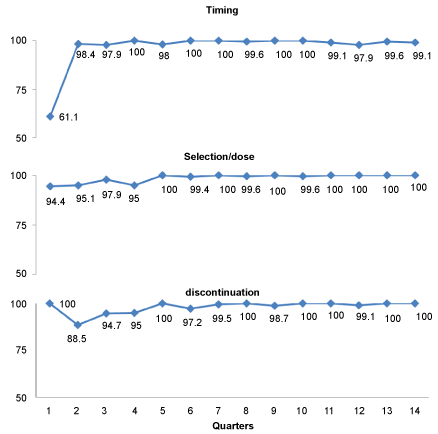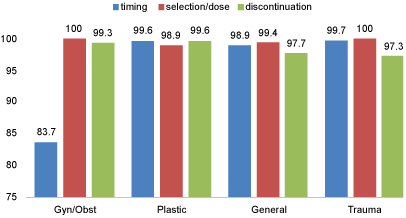Describe the compliance with Antibiotic Prophylaxis (AP) in selected surgical procedures in a community hospital during a 3.5 year period.
Descriptive study was carried out in a 75-bed public hospital in Western Qatar. The study included the patients underwent selected procedures who required antibiotic prophylaxis from Jan-2013 to June 2016. Data was collected by the infection control practitioner, from patient files to assess the compliance with timing, selection and dose and discontinuation of the antibiotic prophylactic as per policy, with a 100% compliance set as a program goal. The local infection control program mandates the monitoring of AP, feedback and staff education.
Data on 2386 procedures was collected. The 46.5% of the procedures were performed by general surgery, with lower frequency for trauma (24.4%), Gyn-Obst (17.8%) and plastic surgeries (11.3%). The compliance with timing and selection and dose was 61.1% and 94.4% during the first quarter, after which was observed figures over 98%. The discontinuation had the lowest figures during the quarter 2 to 4, with increased compliance over 99% after the quarter seven.
Even when the compliance with antibiotic prophylaxis did not achieve the goals, especially for the timely administration, an increased adherence with guidelines was observed during the study period as a result of the strategy implemented by the infection control program.
Antibiotic prophylaxis, Surgical procedures, Compliance, Qatar
Antibiotic prophylaxis constitutes a fundamental practice for prevention of Surgical Site Infection (SSI), which is related with prolonged hospital stay, increased cost and other adverse outcomes [1,2]. The preventable outcomes of inappropriate antimicrobial use include infectious morbidity, sepsis-related mortality, and the incidence of Clostridium difficile infections and the emergence of antimicrobial resistant organisms [3].
The guidelines emphasize on three key issues: The timely administration before surgical procedures, the selection of the antibiotics according to the expected microbial flora in the surgical site, the re-dosing schedule in specific conditions and the duration of the prophylaxis [2]. Published reports describe a variable compliance with guidelines and the effectiveness of an intervention for its improvement [4-9].
In public health hospitals in Qatar, the antibiotic prophylaxis is guided by a corporate policy and the compliance is monitored by the infection control department. The aim of this study was to describe the compliance with antibiotic prophylaxis in selected surgical procedures in a community hospital during a 3.5 year period.
A descriptive study was carried out in a 75-bed public hospital in Western Qatar. The hospital is one of the four general hospitals in the country, and provides services to the population of Western Qatar and patients referred from other healthcare facilities (because of bed crisis). The study included the patients who underwent selected procedures who required antibiotic prophylaxis from Jan 2013 to June 2016. The procedures included the following specialties: Gynecology, obstetrics, plastic surgery, trauma, and general surgical procedures. In general, the procedures could be considered as medium complexity ones and they comprise open and laparoscopic procedures and exclude transplant surgery.
Data of all consecutive procedures that required antibiotic prophylaxis as per corporate policy were collected by the infection control practitioner, using standardized forms, including the necessary information to audit the adherence. Data were collected from the patient files, either from the anesthesia or medication records.
The criteria assessed for antibiotic prophylaxis were as follows: 1) Timing of administration: The initial dose should be within 60 minutes before all procedures, except for cesarean section (15-60 minutes before the procedure), 2) Selection and dose: The selection of the antibiotics (single or combined), and the doses depend on the procedure as defined by the policy, 3) Discontinuation: Prophylaxis should not continue for more than twenty-four hours. The antibiotic recommended for prophylaxis in the selected surgical procedures were cefazolin (1-2 gr), cefuroxime (0.750-1.5 gr) combined with or without metronidazole (0.5 gr).
In clean and clean contaminated procedures is recommended by the policy a single dose of antibiotic except for the following conditions: Prolonged procedures (> 4 hrs or two half lives of the prophylactic antibiotic), blood loss (> 1.5 L for adults and > 25 ml/kg for children) or contamination of the surgical site during the procedure. The alternative for patients with penicillins allergy was clindamycin (600-900 mg).
The corporate infection control program mandates the monitoring of the previously mentioned indicators of compliance with antibiotic prophylaxis, including the monthly feedback to the surgical departments and the infection prevention and control committee for its analysis. The goal recommended for the program was to achieve 100% of compliance with each issue. To achieve this goal the following actions are implemented: Staff education during hiring and on annual basis, monthly monitoring and feedback of compliance, and analysis in departmental meeting.
Waiver of ethical approval was received because the information included is collected routinely by the Infection Control Program as part of the quality improvement program.
The compliance with timing, selection/dose, and discontinuation, was calculated by dividing the number of a prescription, according to the policy, by the number of procedures and expressed by 100 procedures. If more than one antibiotic was prescribed for a single procedure, all of the issues were evaluated separately for each antibiotic, and the compliance was considered for the procedure regardless the non-adherence with guidelines that was documented for one of the antibiotics prescribed.
We collected data on 2386 procedures. The 46.5% of the procedures was performed by general surgery, mainly acute appendicitis, cholecystectomy and hernioplasty. Open reduction and internal fixation was the most frequent trauma surgery (24.4%), Gyn-Obst procedures (mainly cesarean section) accounted for the 17.8% and plastic surgeries (mainly dermolipectomy) for the 11.3% of all surgeries performed.
The compliance with timing achieved the lowest figure during the first quarter (61.1%), after that; figures over 98% were observed. The most frequent procedure related with non-compliance was the cesarean section, especially in emergency procedures. For the selection and dose, the first quarter had the lowest compliance, with higher figures after that, when an improvement was observed with the goal achieved during the latest four quarters. The duration of the antibiotic prophylaxis had the lowest figures from the second to the fourth quarters, with increased compliance after that, mainly related with prolonged prophylaxis in non-complicated appendectomies, hernioplasty and open reduction and internal fixation (Figure 1 and Figure 2).
 Figure 1: Compliance with antibiotic prophylaxis in selected surgical procedures according to quarters (per 100 procedures). View Figure 1
Figure 1: Compliance with antibiotic prophylaxis in selected surgical procedures according to quarters (per 100 procedures). View Figure 1
 Figure 2: Compliance with antibiotic prophylaxis in selected surgical procedures according to departments (per 100 procedures). View Figure 2
Figure 2: Compliance with antibiotic prophylaxis in selected surgical procedures according to departments (per 100 procedures). View Figure 2
The present study demonstrates the improvement in the quality of the antibiotic prophylaxis in line with the infection prevention and control program recommendations. The initial four-quarter period during which the compliance achieved the lowest figures could be related to the implementation of the infection control program in a new facility (opened in the end of 2012). In addition, the staff required educational activities focused on infection prevention and patient safety, which are mandated by the organization that promotes the creation of a strong safety culture as an essential component for quality improvement [10].
The surgical site infection rate in appendectomies achieve the higher figure during first year of study, probably related with deficiencies in the implementation of the control program with a subsequent reduction [11]. Non published data have demonstrated in a logistic regression analysis that improper timing for antibiotic prophylaxis was related with the risk of surgical site infection (Odd Ratio = 44.92, 95% Confidence Interval I, 3.39-594.91). Similar finding was observed in cesarean section [12].
Similar finding to ours had been reported in different settings and countries [13-16]. In our setting, one of the most important challenges was to overcome the previous experience of the staff and provide the best evidence regarding the proper use of antibiotics and to demonstrate the benefits of following it in terms of patient safety and more efficient use of the resources. Regardless the procedures types or the guidelines for antibiotic prophylaxis, the successful combination of an institutional policy, the monitoring of compliance and the feedback and education of the staff constitute the key for achieving the goals and prevent the surgical site infections. Study limitations: It is important to consider that the study is a single center experience. In addition to that, the number of beds and healthcare professionals could be a positive factor to achieve higher compliance, when compared with more complex facilities. Nevertheless, the procedures for monitoring the compliance and the strategies for improvement could be applied in any other facilities regardless its complexity.
In conclusion, even when the compliance with antibiotic prophylaxis did not achieve the goals, especially for the timely administration, an increased adherence to guidelines was observed during the study period as a result of the strategy implemented by the infection control program.
I would like to thank the assistance of Mr. Carlos L Crespo Palacios for reviewing this paper.